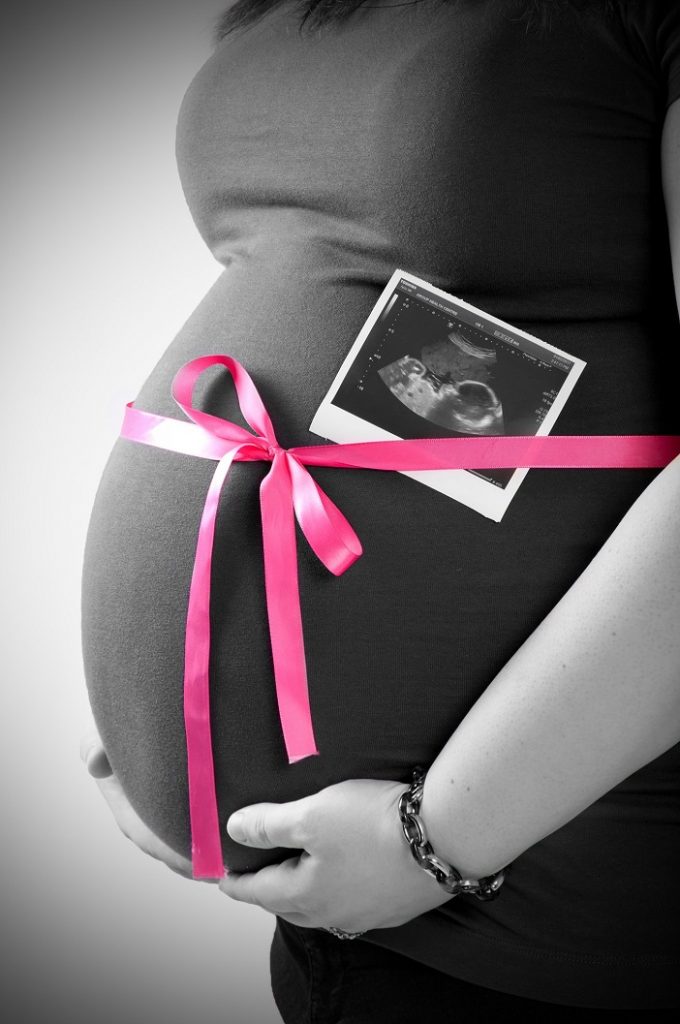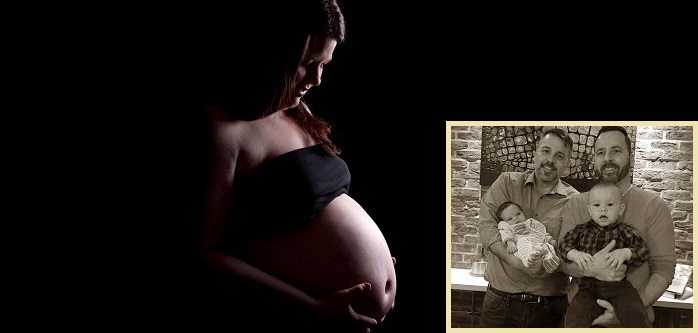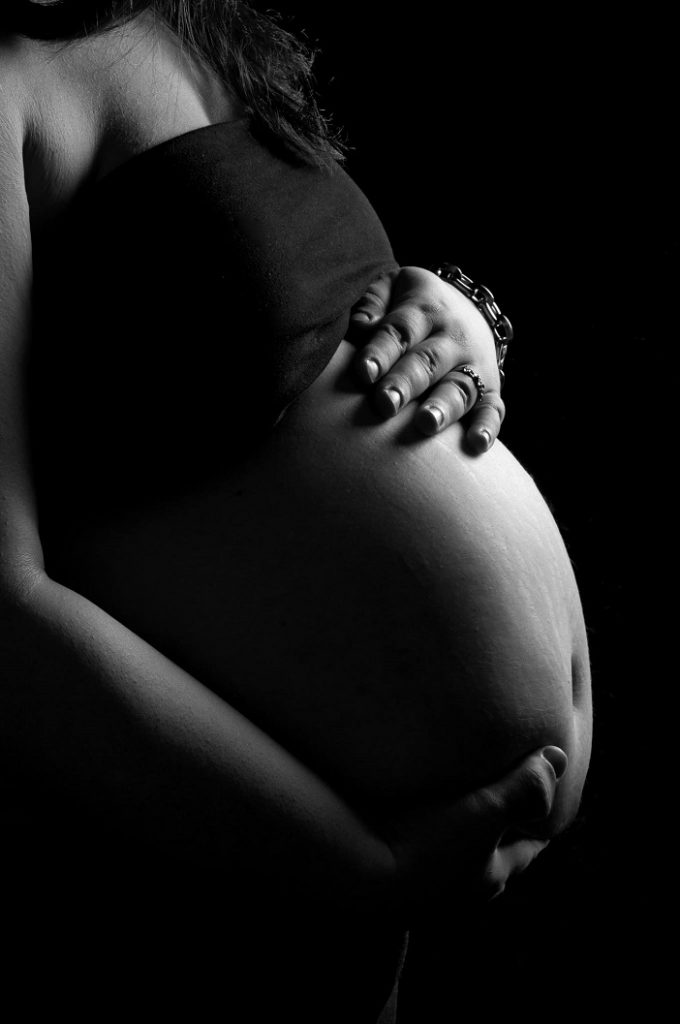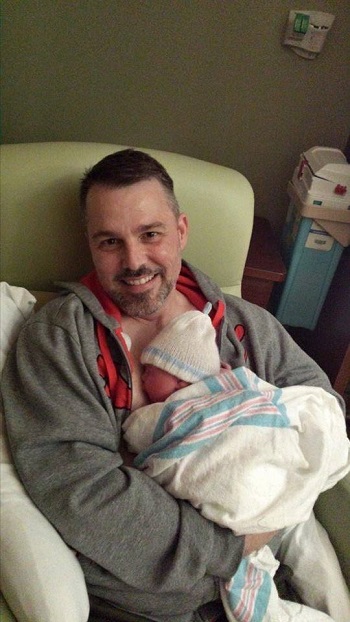
Linsay during one of her two surrogacies with Jean-Yves and Eric. Photography by Cas Evans Photography.
Linsay lives in Sault Ste. Marie. She is a soft spoken and a well-spoken woman of 31 years. She lives a pretty under the radar life and she’s good at it too. She has two children of her own but over the past four years has concealed –for the most part, three pregnancies. Three babies that she carried for two other couples –one in Toronto and one in Quebec. To the first couple she bore a son, and to the second couple, a son and a daughter.
Both gestational surrogacy and traditional surrogacy are legal in Canada. Linsay was a gestational surrogate for all three surrogacies. An embryo created using the biological mother’s egg and father’s sperm was transferred to Linsay for her first surrogacy. For her second and third pregnancy, with the couple from Quebec, both babies were created using Dad’s sperm and the same egg donor.
Traditional surrogacy is differentiated where the surrogate is also the egg donor. This option may seem preferential and spares the expensive costs associated with in vitro fertilization, however, from a legal perspective, traditional surrogacy is risky business.
With no profit to make as a surrogate, Linsay endured the red tape process of the baby money-making industry, as well as the 10 months of pregnancy- three times and then post-partum after shocks –three times, for the sheer love of it.
Adopted as a baby, Linsay was aware of the pain associated with childlessness for those wanting otherwise. “My parents were married for 14 years before they adopted me. They were older parents -41 and 44 when I was a baby. I’ve been thinking about surrogacy since I was a teenager. I remember seeing T. V. movies and stuff like that and thought that was something that I would like to do.”
So when Linsay joined a local Facebook group for moms, and by chance an owner of a surrogacy agency in southern Ontario published a post seeking surrogates, Linsay inquired. That was four years ago. In 2014, Linsay delivered a healthy boy to her first set of parents. Then in 2015, Linsay was connected through the surrogacy agency, to Jean-Yves and Eric. In March 2016, Linsay delivered their son and in April 2017 she delivered their daughter.
“Eric and I met six years ago,” shared Jean-Yves over the phone from their home in Quebec. “Having children was a dream that we both had but we put it aside because we were getting older. But one day we saw on the news another gay couple in Quebec went through the surrogacy process to have a baby. We had many discussions about going with adoption or surrogacy. And I think like most people we had the instinct to have biological children.”
But the process isn’t a linear experience. The intended parents and the surrogate often meet with unexpected financial, physical and emotional costs. But in the case of Jean-Yves and Eric, and Linsay, they would do it all over again.
The Red Tape
Surrogacy law in Canada is governed by two pieces of legislation- the Assisted Human Reproduction Act, and the All Families are Equal Act.
The Assisted Human Reproduction Act serves to regulate human reproduction and related research. The Act contains a sundry of ‘don’t’s’ including the prohibition of creating human clones, or combining the genetic material of humans and non-humans. More relevant to surrogacy is the prohibition of payment to any person who acts as a surrogate. However, it is legal for intend parents to reimburse the surrogate for expenses incurred directly as a result of the surrogacy.
Expenses cover the cost of healthy food, transportation to and from medical appointments, medical processes not covered by OHIP, any time missed from work, and any other related exceptional expense. However, the entire cost to create a family is hard to pin down. Intended parents also foot the bill for legal fees, donor agency, fertility clinic, surrogacy agency, and hospital. Jean-Yves and Eric, admit that the financial cost to create their family exceeded their budget but expressed that their children were too dear to ever name that price.
In November 2016, Ontario passed Bill 28 –the All Families are Equal Act. The bill recognizes “the legal status of all parents, regardless of their orientation, and whether their children were conceived with or without assistance”. The law came into force in January 2017 and provides: greater clarity and certainty for parents who use assisted reproduction to conceive a child; streamlined process for legal recognition of parents who use a surrogate, together with requirements meant to protect the rights of all parties through independent legal advice and confirmation of the surrogate’s consent both before conception and after delivery; and reduce the need for parents who use assisted reproduction to have to go to court to have their parental status recognized in law.
There are critics of the All Families are Equal Act and in a Globe and Mail article, Sara Cohen, fertility lawyer in Toronto, highlights five areas of concern: “the Act does not distinguish between gestational and traditional surrogacy; the new legislation gives the surrogate seven days after birth to change her mind about surrendering the baby, and requires joint medical decision making between the surrogate and intended parents; the Act eliminates any judicial oversight of surrogacy; the Act does not seal the records of children born through surrogacy –as would be done with adoptees to protect privacy; and the Act permits sperm donation through sex where there is a preconception written agreement making the donor not a parent.” The inverse of the final concern meaning should the surrogate mother be privy to such a contract, the child could be left without a legal parent.
However, Linsay expressed that with the passing of the above legislation, the surrogacy process was much smoother.
“After the All Families are Equal Act, the process was much simpler,” remarked Linsay, whose third surrogacy pregnancy occurred as the Act came into effect this year. “All we had to do was sign the affidavit at Service Ontario and then Jean-Yves and Eric filed for the birth certificate instead of going to court and having this whole big process. You don’t need to provide a DNA test or any of that now.”
The affidavit clarifies that both parties have received legal advice, that the surrogate mother agrees to relinquish parentage of the child to the intended parents, and a legal contract has been put in place. A legal contract ensures that everyone upholds their end of the deal.
“This is years of work and planning on the intended parents end, and it’s not all covered by OHIP. This is a for-profit industry,” remarked Linsay. “Although it doesn’t happen often, a surrogate mother may change her mind about relinquishing the baby or even rarer, the intended parents could change their mind. Those are a couple of major reasons why a contract is so important.”
Jean-Yves and Eric live in Quebec but pursued a surrogacy arrangement in Ontario. “Surrogacy contracts or agreements are not recognized here, meaning that the surrogate who gives birth to a child is automatically the mother whether or not it is her embryo that she gives birth to,” explained Jean-Yves. “The surrogate could decide to keep the baby. We could try to have the baby and the judge could disagree and give the baby to the surrogate even if she doesn’t want the baby. So it’s way riskier. That’s why we decided to go in Ontario where the agreements are recognized at least.”
In addition to new legislation, Linsay notes the difference from her first to third surrogacy with her hospital experiences in the Sault. She noted that her first surrogacy delivery in 2014, was not as smooth as her third delivery stating, “This isn’t something you hear of many people doing in the Sault. Since my first surrogacy, a surrogacy policy has been put in place at the hospital.”
Kierston Miron, Patient Care Manager of the Women and Children’s Health Program at the Sault Area Hospital, confirmed that the hospital modeled their surrogacy policy from Mount Sinai –likely a centre that sees far more surrogacy arrangements than the Sault. However, Miron remarked that while surrogacy deliveries are not significant locally, an increase has been noted.
“They really got their act together,” remarked Linsay of the Sault and Area Hospital. “They put in a standard surrogacy form that they have me sign and they have the intended parents’ sign- giving my permission for the baby to be released to them. After this last one was born I didn’t even have a bracelet identifying me as the ‘mother’. A few staff members would refer to me as the mother, but it was really handled seamlessly and the guys- both times, were given a private room with the baby, and both times I could be released right away.”
Before, During and After Surrogate Pregnancy
Jean-Yves and Eric met six years ago and though they both wanted children they shelved the dream thinking that they were past their prime, and how would they go about it anyway? Those were big conversations and ones not to be rushed. Watching the news one day, the Jean-Yves and Eric learned about another gay couple, who also lived in Quebec, who went through the surrogacy process to have a child.
Jean-Yves, Eric, and Linsay all met through a surrogacy agency. The agency screened Linsay for suitability, inquiring about: possible complications with previous pregnancies; would she have enough emotional support through the process; would she have hands on support if she required bed rest; and would she be able to surrender the baby.
Working with a surrogacy agency is something that Linsay recommends for first-timers –whether it’s a first surrogacy for either the surrogate or intended parent, or if it’s a second surrogacy but with new parties. “When it’s your first-time, or your dealing with strangers it’s hard to know what to expect,” remarked Linsay. “Both parties will need legal support, process support. It can be overwhelming if you don’t know what the protocols and expectations are.”
However, the trio agreed that the agency cramped any sort of relationship building between the surrogate and intended parents, making the pregnancy experience a bit rattling for the Quebec couple.
“It was difficult for many reasons. You need to give all your trust to somebody you don’t know. It was ten months of anxiety because you don’t know what she is doing, you don’t know if she’s treating the baby well, if you’re going to have a healthy baby. And at that point, you have no rights as parents until the baby is born,” remarked Jean-Yves.

Jean-Yves (left) and Eric (right). Eric cutting the umbilical cord that connected Linsay and Baby C.
Jean-Yves expressed that at the end of the first pregnancy the trio didn’t have much of a connection. “The agency really made it more difficult than it should have been. At the end of the first pregnancy we didn’t really know her. I would say that we really didn’t meet Linsay until the delivery. And then she came to our house to visit us, and then we started to get to know each other.”
After developing a trusting and friendly relationship together, Jean-Yves and Eric asked Linsay if she would consider being a surrogate for the couple’s second child –this time without the interference from an agency. Linsay had no hesitation.
“It was such a privilege to be asked to carry for them again. I have children of my own and being pregnant as a surrogate was similar as my own pregnancies. You are looking forward to them being born, finding out if they are a boy or a girl, and hoping they are healthy. But you also have a bond with this couple that want this child. And they are excited about it and that’s such a wonderful thing,” shared Linsay. “You don’t have the expectation of taking the baby home with you but you are excited for the couple.”
Of all of her three surrogate pregnancies Linsay added, “By the time they got to the point of having a surrogate they had thought that they would never have the chance of having a baby. It’s really an honour to be able to do that for someone that really wants to have a baby.”
Linsay has tried to be as discreet as possible throughout her three surrogate pregnancies, concealing her baby bump with oversized clothes instead of maternity clothes, and telling only a few close friends and family members about her decision.
“Most people were curious about what I was doing,” she shared. “And some were worried that the parents would change their mind but what people don’t realize is that the expense to the intended parents is significant. This is not something they have entered into lightly. I haven’t worried about that for any of my pregnancies.”
Though there were a few people in Jean-Yves and Eric’s life that were slow to warm up to the elaborate process the couple would undertake to start a family, the couple expressed that they were well supported by their loved ones. “They were surprised but happy,” commented Jean-Yves.
Separated by hundreds of miles, Jean-Yves shared at times it was hard to conceptualize that Linsay was carrying their baby. “Even though she shares the ultrasound pictures, it doesn’t seem as real as it would if she was there beside you with the belly. It all happens in one minute- when she delivers. That’s when it becomes real. It’s almost like a surprise, even for us.”
The miracle of birth is powerful and for the couple, sharing labour and delivery with Linsay forged strong emotional bonds. “These are really intimate moments. These moments make you closer,” shared Jean-Yves.
Jean-Yves also confided that he and Eric felt a lot of empathy for Linsay during the delivery- and not just for the physical endurance and suffering of the past 10 months that led up to a new life emerging into the world. “The delivery was wonderful, for many reasons. There is a woman suffering for you, for your benefit, and you can’t do anything for her. You feel bad and also at the exact moment the baby is born, the nurse takes the intended parents with them to weigh and measure the baby, and you leave the surrogate alone there- it felt bad. Linsay gave birth two minutes ago, and you just leave her there. It’s not a good feeling.”
For Linsay, the moment is joyful but after doing this three times she prepares for the crash after pregnancy. “I have friends that know I’m going to be a wreck for the first week. So I do have support. And the guys are great,” she says of Jean-Yves and Eric. “They text every day and update me. They’re great. I already have a trip booked to go and see them.”
Though Linsay has fulfilled her part of the contract she is still contributing to the health of the newborn as she faithfully pumps, freezes, and express posts to Quebec her breast milk packed in dry ice. “I can ship it overnight and it arrives 21 hours later, still frozen.”
Jean-Yves and Eric offer practical advice to other couples that may be considering surrogacy. “Be prepared to put a lot of trust in people. There are a lot of people involved with your privacy. After a point, it begins to feel like too many people are involved. It is an intimate thing as a couple to have a baby and suddenly, for a year and a half, there’s many people asking you questions, wanting documents, needing money. Even though you budget for the process there are often costs that aren’t anticipated. It gets way more expensive that you though it would be at the beginning. And it’s a very long process. You should not expect to have a baby in one year. It took us four years to have our babies. Four years of process and contacting agencies. And it can fail many times- along the way we lost surrogates, we lost donors, we lost embryos. At many points in the process you want to quit but at the end it is all worth it but it’s not an easy process.”
Jean-Yves and Eric are overjoyed with their family but are not entirely sure if there is a third baby on the horizon. But if so, Linsay is ready.
“I would absolutely carry again if the guys wanted to have another baby,” she smiled. “But I don’t know if I would want to do it with anybody else- it was such a good experience with the guys. It’s hard to believe that it was just three years ago that we met. And it is hard to think about not doing it again. You become kind of addicted. There’s a lot of repeat surrogates. It can be a wonderful experience and it’s very worthwhile.”






